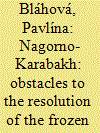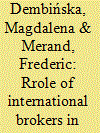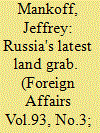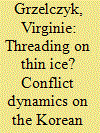|
|
|
Sort Order |
|
|
|
Items / Page
|
|
|
|
|
|
|
| Srl | Item |
| 1 |
ID:
155659


|
|
|
| 2 |
ID:
163160


|
|
|
|
|
| Summary/Abstract |
Frozen conflicts, situations in which war ended yet stable peace did not materialize, trouble both Asia and Europe. Despite the clear policy relevance of this problem, the notion of frozen conflicts remains surprisingly blurred in peace and conflict studies literature. In this paper, we seek to provide a rigorous conceptualization of frozen conflicts. We situate frozen conflicts into a broader debate about enduring rivalries in international politics and demonstrate the theoretical relevance of the term vis-à-vis existing concepts. Furthermore, we outline a theoretical model of frozen conflict dynamics, which portrays frozen conflicts as dynamic configurations undergoing a periodical “thawing” in relations between the opposing sides: either toward diplomatic negotiations (“peaceful thawing”) or re-escalation toward use of armed force (“violent thawing”). We illustrate the usefulness of our model with empirical observations from other articles in this special issue and conclude with possible avenues for further research.
|
|
|
|
|
|
|
|
|
|
|
|
|
|
|
|
| 3 |
ID:
192883


|
|
|
|
|
| Summary/Abstract |
The term “frozen conflict,” which is used to describe identity-based conflicts in former Soviet republics, characterizes a situation whereby neither war nor peace exists between the conflicting parties. The most important of these conflict areas is Nagorno-Karabakh, located in the South Caucasus. As the conflict in the 1990s could not be resolved through negotiations, war broke out again in September 2020. Under the ceasefire protocol signed in November 2020 following the war, Azerbaijan has largely succeeded in liberating its occupied territories around Nagorno-Karabakh. As it is claimed that the occupied territories of Azerbaijan have been completely liberated, this situation raises the question of whether the problem is no longer a frozen conflict. However, when the protocol is considered in relation to the concept's definition, we see that the problem remains a frozen conflict.
|
|
|
|
|
|
|
|
|
|
|
|
|
|
|
|
| 4 |
ID:
163164


|
|
|
|
|
| Summary/Abstract |
The enduring deadlock in peace negotiations between Armenia and Azerbaijan over Nagorno-Karabakh has created a special, “frozen” phase in the conflict cycle. Several cases of skirmishes, escalating in 2016 during the Four-Day War, demonstrate the security threat the conflict represents. Simultaneously, ongoing unsuccessful peace talks and escalations and de-escalations of violence at the line of contact indicate the failure to transform the conflict in either a peaceful or a violent way. This paper seeks to identify conditions contributing to the stalemate of the conflict. The key actors contributing to the conflict’s “frozenness” are the political leadership of Armenia and Azerbaijan and third parties represented by the Minsk Group. The failure to achieve a peaceful transformation is given by political hostilities carried out through negative labelling, uncompromising statements and the self-victimisation of the belligerents. Such activities deepen the grievances within the Azerbaijani and Armenian populaces, which in response to such behaviour does not support any concessions in negotiations. At the same time, the Minsk Group does not provide any concrete model for a peaceful settlement nor does it apply pressure on the belligerents to grant concessions. A violent transformation of the conflict is not possible due to the presence of third parties in the region which deter the belligerents from full-scale war. These findings indicate that in order to avoid the future failure of negotiations and violent escalations at the line of contact, the political leaderships of Armenia and Azerbaijan need to withdraw from mutual hostilities, the negotiation agenda and framework need to be changed and the third parties involved have to actively participate in the peace process.
|
|
|
|
|
|
|
|
|
|
|
|
|
|
|
|
| 5 |
ID:
163161


|
|
|
|
|
| Summary/Abstract |
The “frozen” conflict between Moldova and its separatist Transnistrian region—which developed into a de facto state—is dynamic. Despite an active nation-building project to support Transnistria’s independence and a stated willingness to join Russia, Transnistria is juggling between Russia and Europe. While economically dependent on the former’s subsidies and security guarantees, Transnistrian economic ties with the West are growing strong. While most studies are interested in the geopolitical game and the role of external actors, this article argues for a complementary approach that links macro- with meso-level analysis through the role of externally oriented domestic agents. First, the article shows that Transnistria pursues dual alignment in order to survive and provide the population with public goods for which they need external resources. Although Transnistria relies heavily on its patron state, Russia, facing recurrent crisis and external constraints, it has to search for complementary sources of income. Dual alignment is the result of this “multiple asymmetric dependence.” Second, the article argues that local intermingled economic and political interests, embodied by businessmen with close ties not only to Russia but also to Europe, account for how this balancing act is sustained. These informal international brokers or “double agents” mobilize their political connections to support dual alignment while using their Western and Eastern business connections to consolidate their power in Transnistria. It is further argued that the role of international brokers embedded in Russian and European networks and engaging in cross-border cooperation helps understand why the Transnistrian frozen conflict seems to be withering
|
|
|
|
|
|
|
|
|
|
|
|
|
|
|
|
| 6 |
ID:
130468


|
|
|
|
|
| Publication |
2014.
|
| Summary/Abstract |
Russia's occupation and annexation of the Crimean Peninsula in February and March have plunged Europe into one of its gravest crises since the end of the Cold War. Despite analogies to Munich in 1938, however, Russia's invasion of this Ukrainian region is at once a replay and an escalation of tactics that the Kremlin has used for the past two decades to maintain its influence across the domains of the former Soviet Union. Since the early 1990s, Russia has either directly supported or contributed to the emergence of four breakaway ethnic regions in Eurasia: Transnistria, a self-declared state in Moldova on a strip of land between the Dniester River and Ukraine; Abkhazia, on Georgia's Black Sea coast; South Ossetia, in northern Georgia; and, to a lesser degree, Nagorno-Karabakh, a landlocked mountainous region in southwestern Azerbaijan that declared its independence under Armenian protection following a brutal civil war. Moscow's meddling has created so-called frozen conflicts in these states, in which the splinter territories remain beyond the control of the central governments and the local de facto authorities enjoy Russian protection and influence.
|
|
|
|
|
|
|
|
|
|
|
|
|
|
|
|
| 7 |
ID:
093715


|
|
|
|
|
| Publication |
2010.
|
| Summary/Abstract |
While the proximate causes of the 2008 Russo-Georgian war have yet to be satisfactorily investigated, an assessment of an earlier occasion of conflict in South Ossetia in 2004 can lay the groundwork for an analysis of the later war. Like the 2008 war, the 2004 conflict was comprehensible on the basis of the ambitious war plans of opposing sides, but it was ultimately rooted in a security dilemma. The conflict thus provides a precedent for considering how a mix of limited offensive intentions, insecurity, uncertainty, and cognitive shortcuts and misperceptions had the capacity to lead to inadvertent war between Russia and Georgia over South Ossetia.
|
|
|
|
|
|
|
|
|
|
|
|
|
|
|
|
| 8 |
ID:
163162


|
|
|
|
|
| Summary/Abstract |
In 2018, both the Republic of Korea (ROK) and the Democratic People’s Republic of Korea (DPRK) will mark the 70th anniversary of the establishment of their separate governments. This is a sad reminder that much remains frozen on the Korean Peninsula. For one, families have been separated and communication channels between the two Korean populations are almost non-existent. Yet, stability is precariously established by an Armistice that was signed in 1953 and that was never replaced by a permanent peace mechanism. Moreover, North Korea’s rapid nuclear development has contributed to tensions and uncertainties, and the Six-Party Talks, originally designed to ensure the denuclearisation of the peninsula, has been at a standstill for almost 10 years. The Korean story is thus a prime case to study the dynamics of a frozen conflict and this article contributes to the existing literature and analysis of frozen conflicts by suggesting looking at peaceful and violent thawing, as well as conflict withering. In order to so, the paper focuses on three crucial levels: (1) the micro level, the impact of the Armistice in light of today’s Koreas as opposed to their status and standing at the end of the Korean War in 1953, (2) the meso level with geostrategic concerns concentrated over sectorial policies surrounding the Korean Peninsula in a globalised world, and (3) the macro level with the changing nature of security governance. It is argued that in a catch-22 motion, the thread of violent thawing maintains the conflict in its frozen state.
|
|
|
|
|
|
|
|
|
|
|
|
|
|
|
|
| 9 |
ID:
169279


|
|
|
|
|
| Summary/Abstract |
This research explores strategies led by women´s grassroots organisations and discusses how they can offer opportunities for peacebuilding in frozen conflict settings such as Georgia and the breakaway territories of South Ossetia and Abkhazia. These conflicts are related to separatist aspirations which are based, on the surface, on ethnic differences. However, the precedent of inter-ethnic dialogue shows that there is not an inherent ‘us-against-them’ narrative separating Georgia from Abkhazia and South Ossetia. Therefore, it is possible to create alternative arenas for dialogue and mutual understanding among the parties. To this end, this study adopts a broad approach to peacebuilding as a process of social transformation of hostile attitudes and exclusive narratives. I argue that women-to-women diplomacy is a peacebuilding strategy with the potential to address the roots of polarisation by humanising the other and identifying common ground for cooperation and inter- ethnic dialogue. The empirical research based on the experiences of women’s organisations in Georgia illustrates the contribution of women-to-women diplomacy to peacebuilding as an alternative platform for coalition building based on the common goal of achieving equal rights.
|
|
|
|
|
|
|
|
|
|
|
|
|
|
|
|
|
|
|
|
|